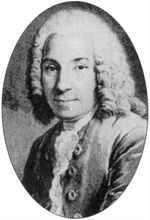<Back to Index>
- Economist Friedrich August Hayek, 1899
- Composer Karl Philipp Stamitz, 1745
- Mayor of Amsterdam Nicolaas Witsen, 1641
PAGE SPONSOR


Karl Philipp Stamitz (Czech: Karel Stamic; baptized 8 May 1745 – 9 November 1801), who later changed his given name to Carl, was a German composer of partial Czech ancestry (his mother was German), and a violin, viola and viola d'amore virtuoso. He was the most prominent representative of the second generation of the so-called Mannheim School.
He was the first composer to specify a left hand pizzicato (an important virtuoso device) in a composition. This occurs in his famous Viola Concerto in D major where the passage in question is designated by an "0" above the notes. This happened decades before Paganini would designate the same effect with an "X" above the notes.
A good composer of impeccable musical pedigree and training, he is particularly remembered for his melodious clarinet and
viola concertos which are played to this day. Although a talented and
prolific composer of great aspirations, he never succeeded in attaining an adequate position with one of the major princes or
orchestras of his time – whether for want of trying or because of his
unsteady and itinerant lifestyle is not clear. He died in poverty; a
small town music teacher who in his last years turned to alchemy in search of making gold. When nine years after his death (1810) his estate was put up for auction to cover his debts nothing was sold and all of it consequently lost. Carl Stamitz was the first son of Johann Stamitz (1717 – 1757), a violinist and composer of the pre-classical area who not only composed some of the best instrumental music (symphonies, concertos)
between Bach and Mozart, but as leader and first violinist also turned
the Mannheim court orchestra into the best one in Europe. Carl Stamitz was born at Mannheim precisely
at the moment when the Mannheimers began their comet - like ascent and
the "Mannheim Gout" (“taste”) was causing a sensation all over Europe.
As a boy he received his first lessons in violin and composition from
his father. After his father's early death, Stamitz was taught by Christian Cannabich (1731 – 1798), his father's successor as concert - master and leader of the Mannheim orchestra. Ignaz Holzbauer (1711 – 1798), the court director of music, and the court composer Franz Xaver Richter (1709 – 1789) also had a hand in his education. By
the time he was 17 Stamitz was employed as a violinist in the
court orchestra. This position did not keep his interest for very long,
though: In 1770 he resigned from his post and began an unsettled and
vagrant life that, with occasional breaks, would last for the next 25
years and would lead him all over Europe.
It is bewildering to this day that this man, scion of one of the
pre - eminent musical families of 18th century Europe, supremely taught
by some of its best musicians, well connected in aristocratic and
musical circles, multi lingual, versed in all musical matters and a
genuinely good composer would die in penury as an ordinary music
teacher in a minor German city – but this is exactly what happened. As
a travelling virtuoso on the violin, the viola and viola d'amore
Stamitz often accepted short term engagements but never managed to gain
a position adequate to his abilities with one of the European princes
or in one of the prestigious orchestras of his time. In 1770 Stamitz
went to Paris where he went into service with Duke Louis of Noailles,
who made him his court composer. He also appeared in the Concerts
Spirituels, sometimes together with his brother Anton, who probably had
come to Paris with him. With Paris as his base he made frequent concert
tours to a number of German cities. On 12 April 1773 he appeared in Frankfurt am Main, a year later in Augsburg, and in 1775 he ventured as far as St. Petersburg in Russia. In 1777 he dwelt for a time in Strasbourg where Franz Xaver Richter, his father's old friend, was music director. During the years 1777 and 1778 he was successful in London, one of many Austro - German musicians (Carl Friedrich Abel, Johann Christian Bach, and in his last years Joseph Haydn would
be some other ones) to be drawn to that metropolis where a capitalist
music life, largely independent of courts and nobility, was already in
full swing. His stay in London was possibly facilitated through his
contact with Thomas Erskine, Earl of Kelly (1753 – 1781), who during a
tour of the continent had received lessons from Carl’s father Johann
Stamitz. Between 1782 and 1783 we find Stamitz in the Netherlands where he gave converts in The Hague and in Amsterdam. Finally in 1785 Stamitz returned to Germany to appear in concerts in a number of cities and towns, e.g. Hamburg, Lübeck, Braunschweig, Magdeburg, and Leipzig. In the April of 1786 he made his way to Berlin where on 19 May 1786 he participated in the famous performance of Handel's Messiah under Johann Adam Hiller's baton. Years of ever more restless travelling were to follow. He emerges in Dresden, Prague, Halle and finally in Nuremberg, where he staged a Great Allegorical Musical Festivity in Two Acts celebrating the balloon ascent of the French aviation prioneer Jean Pierre Blanchard (3 November 1787). During the winter of 1789 - 90 he directed the amateur concerts in Kassel, failed to gain an employment with the Schwerin court which forced him, by now married and father of four children who all died in infancy, to hit the road one more time. On 12 November 1792 he gave a concert in the Weimar court theatre (then under the direction of Johann Wolfgang Goethe).
In 1793 he undertook one last journey along the Rhein to his native
Mannheim before he finally gave up travelling for good. Sometime in the
winter of 1794 - 95 he moved his family to the university town of Jena,
where his wanderings came to an end. When
Stamitz settled in Jena the town had less than 5,000 inhabitants, the
first steam engine lay still 70 years in the future and there was just
a handful of real workers living there. Jena was still by far and large
an almost medieval town surrounded by a mostly agricultural society. At
the same time this old town with its cobbled streets and Tudor style
houses was home to one of the most prestigious German universities.
Eminent Poets, writers and historians such as Friedrich Schiller, August and Wilhelm Schlegel and the philosophers Johann Gottlieb Fichte and Georg Wilhelm Hegel all
were professors at Jena University. During the 1790s the poet Johann
Wolfgang von Goethe spent several months there every year to indulge in
private anatomical studies. Musically,
though, the town was a backwater. During the years Stamitz spent there,
Jena had neither a town band nor an orchestra to speak of. According to
some sources he was in some way connected to the university but this
seems a matter of dispute. After
his death a substantial number of tracts on alchemy were found in his
library. From this it was guessed that he dabbled in attempts of gold
making. Stamitz gradually descended into poverty, but his imagination
kept him going. For years he hatched grand plans about operas and
future concerts that would bring him money and possibly redeem him
before society. Until his last days there were plans that he would
travel to Russia one more time where money was to be made. Even in a century of industrious and prolific composers, Carl Stamitz stands out. He wrote more than 50 symphonies; at least 38 symphonies concertantes; and more than 60 concertos for Violin, viola, viola d'amore, cello, clarinet, Basset horn, flute, bassoon, and other instruments. He also wrote a good deal of chamber music for
various combinations. The sheer quantity of Stamitz’ output is
comparable to Mozart’s. Some of his clarinet and viola concertos are
among the finest there are and a welcome addition to the not so ample
concerto repertoire for both instruments. Although
no clarinet player himself, Stamitz had a profound understanding of
this instrument which dated back to his early years with the Mannheim
orchestra. During his Paris years (1770 – 1778) Stamitz began to
cooperate with the Bohemian born clarinet virtuoso Joseph Beer (1744 – 1811)
which proved fruitful for both Stamitz and Beer. Al least one of
Stamitz's clarinet concertos (concerto No. 6 in E-flat major) seems to
have been jointly composed by Stamitz and Beer as both names appear on
the title page of the Viennese manuscript. Stamitz's cello concertos
were written for the cello - playing Prussian King Frederick William II, for whom both Mozart and Beethoven also wrote music. Stylistically
Stamitz's music is not too far from the works of the young Mozart or,
for that matter, from Haydn's middle period. A musical layman would
perceive but little difference between a Stamitz symphony and one of
the early Mozart symphonies. Stamitz's
orchestral writing is fluent and graceful; the sections of the
orchestra are well contrasted as was the Mannheim wont, the voices for
the individual instruments well laid out. His works are characterized
by regular periods, well crafted themes and appealing melodies, with
the voices quite often led in thirds, sixths and tenths. As a
travelling virtuoso who must have appeared in a few thousand concerts
during his lifetime, Stamitz knew the tricks of the trade. The writing
for the solo instruments is idiomatic and virtuoso but not excessively
so. The
opening movements of Stamitz's concertos and orchestral works are
regularly constructed in the sonata form with an extensive double
exposition. Their structure is additive in nature, however, and does
not exhibit the thematic development so typical of the Viennese
classical style. The middle movements are expressive and lyrical,
sometimes called “Romance” and usually constructed according to the
well known Liedform (ABA, ABA' or AA'B). The final movement is often (in the concertos almost always) a French style rondo. Just
as his teacher Franz Xaver Richter had done, Stamitz preferred minor
keys as he generally used a variety of (sometimes remote) keys.